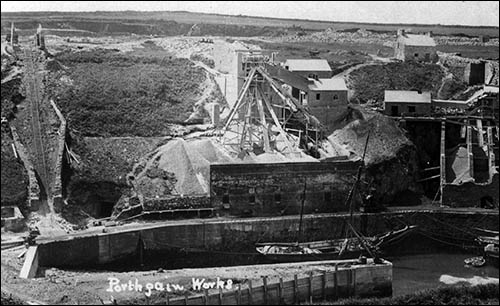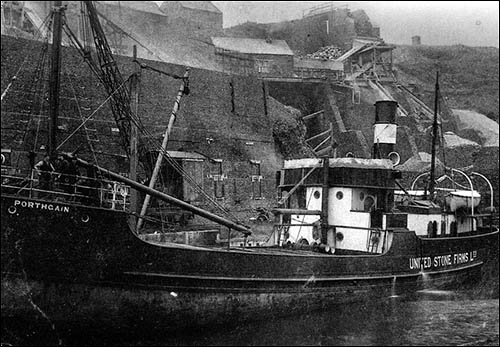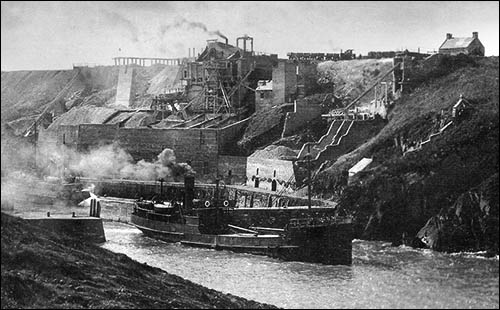Porthgain harbour and quarry hoppers
Porthgain was once a peaceful tidal creek, home to three fishermen's cottages and two limekilns. High tide reached the first cottage, where the Sloop Inn stands today.
 All this changed in 1851 when the owners of the nearby Abereiddi slate quarry sought a better method of exporting slate than using the beach at Abereiddi, where vessels would run ashore at high tide for loading at low tide and departure on the next high tide. Only small vessels, carrying 30 tons or less, could be used, and the weather and tides made the operation hazardous. One vessel leaving Abereiddi was wrecked in a gale in August 1838.
All this changed in 1851 when the owners of the nearby Abereiddi slate quarry sought a better method of exporting slate than using the beach at Abereiddi, where vessels would run ashore at high tide for loading at low tide and departure on the next high tide. Only small vessels, carrying 30 tons or less, could be used, and the weather and tides made the operation hazardous. One vessel leaving Abereiddi was wrecked in a gale in August 1838.
In 1851 the quarry company built a tramway to Porthgain from Abereiddi quarry, and two stone piers each side of Porthgain harbour’s entrance to improve shelter. A wharf was cut into the western cliff and equipped with a crane. Today the coast path, heading west, runs along the wharf and up the steps past the Pilot's House, where the harbour pilot had his office.
Porthgain developed into a bustling industrial village and port. Slate and granite were quarried near Porthgain and exported from the harbour. Hundreds of thousands of bricks were exported too, after Porthgain brickworks opened in 1889.
 Remodelling began in 1898 for the harbour to accommodate larger steam cargo vessels. The improvements took six years and included constructing the central quay and lengthening the western pier. At the same time, towering hoppers were built from Porthgain bricks to hold crushed granite roadstone destined for macadam roads throughout South Wales and South-west England – click here for our page about the railway which brought the granite to the harbour.
Remodelling began in 1898 for the harbour to accommodate larger steam cargo vessels. The improvements took six years and included constructing the central quay and lengthening the western pier. At the same time, towering hoppers were built from Porthgain bricks to hold crushed granite roadstone destined for macadam roads throughout South Wales and South-west England – click here for our page about the railway which brought the granite to the harbour.
Smooth, well-drained roads were built up in layers of stone in various sizes, from 75mm (3 inches) at the base to dust on the surface. Here the quarried stone was brought to crushers above the harbour and crushed into 12 different sizes. It was then dropped into the storage hoppers, each holding a different grade of stone.
 The smaller hoppers have tunnels under them, where trams were loaded directly from openings in the tunnel roofs. The trams were then pushed to the quayside, where steam cranes emptied their loads into ships’ holds.
The smaller hoppers have tunnels under them, where trams were loaded directly from openings in the tunnel roofs. The trams were then pushed to the quayside, where steam cranes emptied their loads into ships’ holds.
The taller hoppers have front openings where wooden chutes loaded stone directly into adjacent vessels. The company at that time, United Stone Firms, had its own steamships including SS Porthgain (middle photo), wrecked in 1913 in Jack's Sound, near Skomer Island.
Today the harbour is used by local commercial fishermen and recreational users. It is owned and maintained by the Pembrokeshire Coast National Park Authority, along with the hoppers and crusher, now protected as a Scheduled Ancient Monument.
With thanks to Philip Lees
Postcode: SA62 5BN View Location Map

